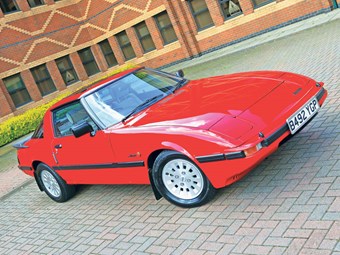After a Japanese coupé that isn’t a Nissan Z-car? Try a Series 1 RX-7...
Launched in 1978 and produced until 1985, the first generation RX-7 was the car that made Mazda’s name throughout Europe. The curious little rotary-engined sports car also demonstrated that NSU’s supposed folly could be made to work; in fact, many RX-7s ended up donating their engines to the stylish Ro80.
The RX-7 also kicked off a succession of world-class Mazda sports cars that has encompassed landmark vehicles like the MX-5 and RX-8. It’s the perfect alternative for anyone who wants a coupé with charm, something Japanese that isn’t a Z-car or who is intrigued by the smoothness and engineering of a rotary engine. Here’s what you need to know.
VITAL STATISTICS
Mazda RX-7
Engine 1146cc/twin rotor
Power (bhp@rpm) 100bhp@6000rpm
Torque (lb ft@rpm) 105lb ft@4000rpm
Top speed 122mph
0-60mph 9.2sec
Consumption 22-25mpg
Gearbox 5-speed manual
WHAT TO LOOK FOR
BODYWORK & CHASSIS
Rot killed off most of the UK’s first generation RX-7s – and those used to British sports cars will be unsurprised by just how prolific corrosion can be. Wheelarches are the first to go, followed by the floorpans, sills and rear suspension mounts. If it’s not a museum piece, just about every example will probably have had work in these areas, so don’t disregard a car that has had welding, as long as
the work is to a high standard. The inner wings, windscreen corners and footwells are other key rot spots, and it pays to make sure the metal beneath the back seat is solid.
ENGINE
Oil leaks from the front and rear crankshaft seals aren’t unknown, but the rotor tip seals are a far more common problem. Parts aren’t expensive, but fitment is a specialist job and the hours soon mount up. When warm, the oil pressure should be 60psi at 4000rpm. Check the unions on the oil cooler; they can crack. Oil losses are bad news, as it provides a third of the cooling as well as lubricating the engine. A compression test is a professional job – anything under 75psi, walk away. Engines can last for hundreds of thousands of miles, provided the oil is changed every 3000 miles. Smoke indicates worn oil control rings, unless it’s white, which means coolant is passing the ring squares
– the rotary equivalent of head gasket failure.
RUNNING GEAR
You’ll get 100,000 miles from both the clutch and gearbox. Worn lower balljoints can be an issue, but these are still available. Bushes wear too, but polybush kits are available which should alleviate any issues and are a desirable upgrade. RX-7 steering was by recirculating ball, not rack-and-pinion – excess play can be sorted, but it’s a haggling point. Dead steering feel indicates it’s been overtightened, which is equally bad news.
INTERIOR
The velour trim is hard-wearing but near-impossible to replace when
it gets tatty. Some cars have the desirable optional leather interior, which can be retrimmed at a price. Check that the appearance matches the mileage covered – the service history should give you the necessary clues. Dashboards rarely crack, which is
a good thing since they are difficult to remove. However, the seats collapse as they get older.
Used replacements are rare – the best option is to refurbish the existing seats – while electric window switches and rear wipers are known to burn out. Barring this, there aren’t really any electrical concerns. In fact, it’s one of the RX-7’s strong suits.
OUR VERDICT
Enthusiasts who gravitate towards the first generation RX-7 are usually on the lookout for a wedgy 1980s coupé that isn’t a Porsche 944. It’s a slightly leftfield choice, but there’s no denying its intelligent, forward-thinking design and a sense of delicate style that later versions of the RX-7 arguably lacked. It’s also a proper sports car with a beautifully balanced rear-drive chassis, optimum front/rear weight distribution and an engine that begs to be revved.
